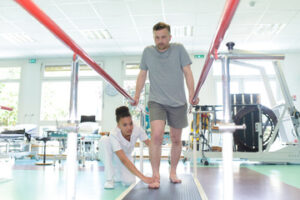Bathroom Remodeling Jacksonville involves renovating or changing your bathroom’s layout, fixtures, flooring, and paint. It is also important to bring plumbing and electrical up to code.

A renovation can include anything from repainting and swapping out the vanity to installing a new tub and shower. A full remodel is more intensive, involving demolition and construction.
The bathroom layout is the most important aspect to consider when renovating a bathroom. It dictates the position of all fixtures and accessories and how much space you will have to move around the room. There are various layout options available to suit different needs and budgets. Choosing the right one will help you create a beautiful and functional space that will leave you with an “ahh” moment every time you step into your bathroom.
The layout is determined by the space you have, the plumbing hookups, and the existing floor and wall layouts. If you are installing a new floor it may be easier to relocate the plumbing rather than work around it. However, moving pipes can be costly and will add to the overall cost of your project. If you are able to stay with the original layout of your plumbing and rework it instead then that is probably the best option for most people.
Whether you are looking to create a sleek modern or elegant traditional space the bathroom layout will define your space and influence the design choices you will make. The space you have to work with and your budget will be the main influencing factors but don’t let that stop you from being creative.
This example of a simple and effective bathroom layout shows how geometric shapes can set the tone for a space. The layout utilises the length of the room with rectangular fixtures that are all placed in a recessed area. A large bathtub is situated at one end while a compact WC sits on the other. The middle of the space is used for a double basin with opulent mirrors that reflect light to create a sense of space and amplify the natural light from the window.
The layout of this luxurious space is ideal for those with a larger space to work with. The central space is dominated by a circular tub that is surrounded on the side with a symmetrical linear arrangement of 2 washbasins and a toilet. The back of the room sees a dedicated showering area and another WC separated by glass panels that function to mark out distinct areas. This is a great way to use glass to separate spaces while still allowing for a clear flow of movement in a room.
Bathroom Design
Bathrooms come in all shapes and sizes, from small powder rooms to spacious master suites. However, no matter the size or style of a space, there are certain design elements that every remodel requires.
Before starting the remodel process, it’s important to understand your design goals for the new space. This includes determining your budget and the scope of work, as well as defining a style for the room.
To create a space that reflects your personal style, look to current trends in bathroom design for inspiration. For example, contemporary design is characterized by fluid forms and innovative materials, while farmhouse style uses natural materials like wood or stone to create a warm, inviting feel.
Another consideration is how the bathroom will function in the future, particularly if you plan to remain in your home as you age (known in the industry as aging in place). Make sure to consider how your lifestyle may change and incorporate features that will allow you to live comfortably at any stage of life, such as easy-to-open handles on cabinets and tubs or non-slip flooring.
While your budget will be a key factor in deciding what to include or exclude, don’t be afraid to think big. A well-planned bathroom remodel can add substantial value to your home. To ensure that you’re not overspending, it’s important to research the resale values of similar homes in your area and speak with professionals about any changes that could increase or decrease your home’s value.
Plumbing is one of the most costly aspects of a bathroom remodel, so if possible, try to stick with the existing layout. Relocating or moving pipes can significantly increase costs and may even cause plumbing problems down the line. If a major change to the layout is necessary, be sure to consult with a professional about potential plumbing complications that can arise during the remodeling process.
Using software like Cedreo can help you plan your remodeling project and stay within your budget. With advanced 3D visualizations, you can easily see how different designs will look before any construction begins. The software also includes a comprehensive library of materials and fixtures to help you find the perfect products for your remodel. You can even use the tool to get cost estimates for your project and compare prices between options.
Bathroom Fixtures
The fixtures of a bathroom make it unique and reflect the homeowners’ personal style. Modern fixtures offer sleek lines, while vintage and traditional options add classic appeal to any bathroom. The type of lighting and the style of door also influence a room’s ambiance. A well-lit space creates a relaxing spa-like experience, while brighter light helps invigorate morning routines.
Whether it’s a freestanding tub, rain showerhead, pedestal sink or touchless faucet, these accessories offer the ability to transform the bathroom into a beautiful retreat. A popular trend in hardware and fixtures is matte black finishes, which create a clean, contemporary look. Also, many people are opting for hand-held showerheads that provide a more luxurious and relaxing experience. Other popular trends include glass vessel sinks, wall-mounted toilets for a sleek design and touchless faucets that are more hygienic.
While a bathroom’s functionality is top of mind, it should also be a place to relax and indulge. Upgrades such as a towel warmer, smart showerhead or unique storage solutions are a great way to add a designer touch without breaking the bank.
Bathrooms consume a significant amount of energy through daily grooming, long showers, lighting demands and plugged-in devices. Installing new energy-efficient appliances can save money while cutting down on environmental impact.
Hardware and fixtures should be proportionate to the size of a room. Oversized pieces can overwhelm small bathrooms, while diminutive options may be lost in a larger space. They should also be aligned with the overall design theme, whether that is contemporary, transitional or traditional.
Aside from the style, materials and colors of bathroom hardware and fixtures can affect the cost. For example, a more expensive type of material or finish might increase labor and installation costs. Geography, permitting requirements and unforeseen repairs are other common factors that can increase the overall cost of a bathroom remodel.
A bathroom remodeling project can be a major investment, so it’s important to choose a reputable and experienced contractor. Commonwealth Contractors offers a transparent process, providing a detailed proposal and estimate that is accurate. They only use high-quality products and materials, ensuring that their clients’ investment is protected.
Bathroom Accessories
Bathroom accessories can help define your space’s design. From towel racks that seamlessly blend with your fixtures to sleek bathroom soap dispensers, the right items can elevate your space and offer lasting practicality. Consider factors like functionality, material durability and budget when selecting bathroom accessories. Multifunctional pieces, like a wall-mounted soap dispenser and toothbrush holder, can free up space on your counter and make cleaning easier. Over-the-door storage for towels, robes and bath products is another smart choice in tight spaces.
Coordinating bathroom accessories creates a cohesive, polished look that enhances both function and style. When choosing bathroom accessories, keep in mind the finishes and styles of your other fixture selections. Using similar metals, such as chrome, nickel and brass, across your hardware, lighting, faucets and accessories ensures that everything flows smoothly.
The materials and textures of your bathroom accessories can also contribute to the overall aesthetic. Durable, weather-resistant materials, like stainless steel, tempered glass and high-quality ceramics are designed to last, especially in humid environments. The finish is equally important, as it’s the first thing to wear away over time, so choose a durable coating that resists scratching and stains.
When selecting bathroom accessories, it’s also important to consider the color. Light tones, reflective surfaces and transparent materials allow natural light to flow freely throughout the room, enhancing the bathroom’s overall brightness and openness. Dark-colored accessories, on the other hand, can absorb light and create a moody feel.
If you’re designing a modern or contemporary bathroom, the use of neutral tones and minimalist designs provides a clean, crisp aesthetic. For a more rustic or traditional vibe, warm colors, rich woods and textured surfaces add visual interest. The use of accent furniture, like stools and tables, helps to add balance and dimension to your bathroom.
